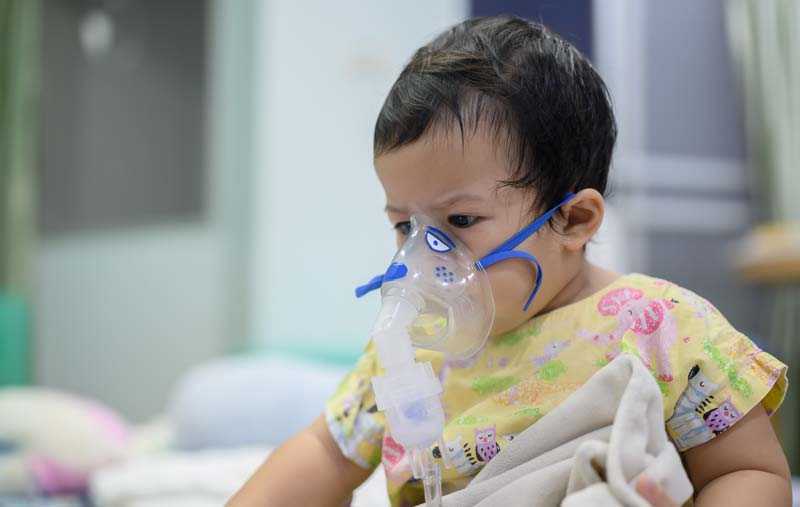Asthma


Asthma is a lung disease that causes the airways to narrow, making it difficult to breathe. Asthma is a chronic condition which means, once diagnosed, you will have it for the rest of your life.
You can develop asthma as early as in the infancy or as late as in your old age. The good news is that with careful monitoring and treatment plan, asthma can be managed well.
Asthma affected about 339 million people worldwide, as per the Global Asthma Report 2018 and caused 0.40 million deaths in 2015.
Although there is no permanent cure for asthma; patients can manage asthma symptoms with inhaled medications. With proper treatment and lifestyle modifications, asthma patients can lead a normal life.
If you are someone who is battling Asthma, do not fall for unverified therapies and home remedy suggestions to manage the disease, only follow qualified medico advice and trusted health websites for your lung health queries.
In a healthy lung, the lining of the airways is open and clear, while the muscles surrounding the airways are relaxed. This allows free movement of air in the lungs. With asthma, three things happen—often at the same time—that make it difficult to breathe:
Asthma in children is considered to be one of the most common chronic lung diseases. It develops before the age of 5 in kids and can cause frequent hospitalization and missed school days. Childhood asthma is more common in boys than in girls.
The exact cause of childhood asthma is unknown, but experts believe that genetic and environmental factors play a crucial role in asthma development at an early age.

Having a family history of asthma and certain environmental factors (like smoke, dust, pollen etc.) are some of the important risk factors for developing asthma.
Exposure to asthma triggers (smoke, dust) may cause an asthma attack. When left untreated, an asthma attack may cause life-threatening complications and even death.
If your child is diagnosed with asthma; you need to create an “asthma action plan” with your doctor. With the right treatment, you can manage your child’s asthma symptoms and prevent asthma attacks.

The symptoms of asthma include:
Symptoms and severity of asthma may vary from person to person. Even in the same patient, asthma symptoms change from time to time. The tightening of muscles around the airways causes an asthma attack. It causes serious shortness of breath, tightness or pain in the chest, wheezing and coughing.
Several factors are considered during the diagnosis of asthma. The doctor will conduct a physical examination, understand the medical history and recommend lung functions tests.
Medical history:
The Doctor will record your medical history, family history and ask questions regarding development of asthma symptoms. This will help the doctor understand the disease and confirm the diagnosis.

Physical examination:
Doctor examines your nose, throat and upper respiratory ways. He will listen for respiratory sounds, to detect wheezing and other abnormal respiratory sounds.
Lung function tests:
The two common lung function tests conducted are spirometry and peak flow tests.
Spirometry is a simple test performed under the expert guidance by using a device called a spirometer. This test helps diagnose lung diseases like Asthma and Chronic pulmonary obstructive disease.
While performing this test, breathe through a plastic mouthpiece by wearing a nose clip. Take a deep breath and then blow the air out as fast as you can. This helps your healthcare provider see how well your lungs are working.
The Peak flow test is another useful test for knowing how fast you can breathe out through your lungs. A hand-held device known as the peak flow meter is used to monitor the asthma symptoms.
The doctor will assess all the results from these tests and deduce the type of asthma you have. They will develop a treatment plan based on the type and severity of your symptoms.
It’s often difficult to diagnose asthma in children under 5, particularly as they find breathing tests difficult. Your doctor will assess your child’s symptoms and your explanation of their symptoms, and may give your child asthma medicine to measure its effect–this is called a ‘treatment trial’. Your doctor will monitor the effect this medicine has on your child and will use the results as part of their diagnostic process.
Asthma is more likely to be diagnosed if your symptoms:

Treatment and management of asthma involves multiple steps. Record your symptoms carefully and know the triggers that cause asthma attacks or flare-ups.
It is important to create an “Asthma action plan” with your doctor or allergist to manage your asthma better. There are various types of medication options (like inhalers [preferred], oral medications, etc.) that are available for managing asthma. Your doctor will decide what works best for you as per your individual symptoms and other factors like your age and frequency of symptoms.
These are some commonly used medications for asthma treatment.
These medications are called “Controllers”. These are most important medications for asthma treatment. Long-term asthma control medications usually take time to act, but they are the most effective in managing asthma symptoms.
They help in reducing swelling around the airways and prevent asthma attacks. Doctors recommend taking them daily and they adjust the dose as per the intensity of your symptoms. Some commonly used long-term asthma medications include - Inhaled corticosteroids, leukotriene modifiers and combination inhalers.
These medications are called “Relievers”. Also known as rescue medications, these medications are used for short-term control of acute asthma symptoms. They help to dilate narrow airways during an asthma attack. The doctors often advise the use of rescue inhalers before exercise to prevent an asthma attack. Beta-agonists, anticholinergics, theophylline are some commonly used quick-relief asthma medications. They are also called bronchodilators.
Sometimes oral allergy medications are also used as an additional treatment. They are helpful when your asthma is triggered by allergies.
Allergy shots or immunotherapy involves inserting a gradually increasing dose of allergens (something that the person is allergic to). This help in reducing the allergen sensitivity of the immune system and prevents allergies and asthma attack in the future.
Though asthma is a serious lung disease; it can be managed effectively. Following the treatment plan properly and taking prescribed medications regularly can let the asthma patient lead a normal and active life.
Keep a record of asthma symptoms
If you or a family member have breathing difficulties, keep a diary of symptoms to discuss with your doctor. You could also make a video or audio recording of the wheezing using your mobile phone.

The diary may include:
Asthma attack is the sudden worsening of asthma symptoms. In this situation, the muscles around the airways are tightened excessively – known as bronchospasm. During an asthma attack, the lining of the airway also becomes swollen and thicker than normal mucus is produced. All these factors combined cause an asthma attack.
Apart from the regular asthma symptoms of wheezing, coughing, shortness of breath, there could be some other severe symptoms that should prompt you to visit a doctor immediately. The other asthma attack symptoms include:
An asthma patient might go without an asthma attack for long durations. Mild asthma attacks are common and the patient feels better within a few minutes or a few hours of treatment. Severe asthma attacks are not so common, but in such a situation, it is important to seek medical help immediately. In severe asthma cases, the chest may tighten so much that the wheezing stops. This, however, does not mean that the patient is feeling better, but it is a sign that there is a dangerous dip in the air movement in lungs. This is also called a silent chest and requires immediate medical attention. Severe asthma attacks are dangerous as without immediate and aggressive medical treatment the patient may lose consciousness or even die of an asthma attack.
Asthma attacks can be prevented if early warning signs are recognized and treated well. Some of the early warning signs of asthma attack are:
Do not ignore these symptoms as without proper treatment they could quickly escalate into an asthma attack.
If you or your loved one is having an asthma attack, it is important to stay calm and follow the asthma action plan. Call for an ambulance or medical help immediately.
Till the help arrives, follow these steps
Usually, rescue inhalers are enough to treat an asthma attack, however, if the symptoms do not go away it is important to follow-up with the doctor. Discuss the situation and understand the level of activities that can be undertaken and any possible change in the treatment plan and inhaler device.
It is important to monitor the symptoms and treat them immediately. As asthma attack develops slowly, recognizing any unusual symptoms may give headway in identifying an impending attack.
Taking the preventive asthma medications as prescribed by the doctor is important in preventing future asthma attack.
Continue to follow the asthma prevention tips like identifying triggers and staying away from them, maintaining healthy weight, not smoking and getting flu vaccines every year.
Cold and frigid air might irritate the lungs, hence covering your mouth will help to warm the air.
Close family and friends are the support system for an asthma patient. These close connections can provide emotional and practical support to make the life of the patient easier. It is also beneficial for the family and friends to know how to help the patient in the event of an asthma attack. Being well informed about asthma and the way to manage it helps build confidence in the family and prepares them to handle stressful situations like an asthma attack.
In case of children or older patients, family is involved in various ways, right from soothing them to helping them get the tests done and have relevant medications. In such situations, it is important for the patient’s family to know the asthma action plan and visit a doctor with the patient to understand the prognosis and management plan.
© 2025 Healthy Lungs.